How Far Apart Should Solar Pathway Lights Be?
Solar pathway lights have become a popular choice for homeowners and landscapers seeking energy-efficient lighting to enhance safety and aesthetics in outdoor spaces. A common question when installing these lights is: How far apart should solar pathway lights be placed to achieve optimal illumination and visual appeal? The answer depends on factors like light brightness, pathway design, and environmental conditions. This article explores the ideal spacing for solar powered lights, their technical specifications, and practical tips for installation, providing a comprehensive guide for creating a sustainable outdoor lighting solution.
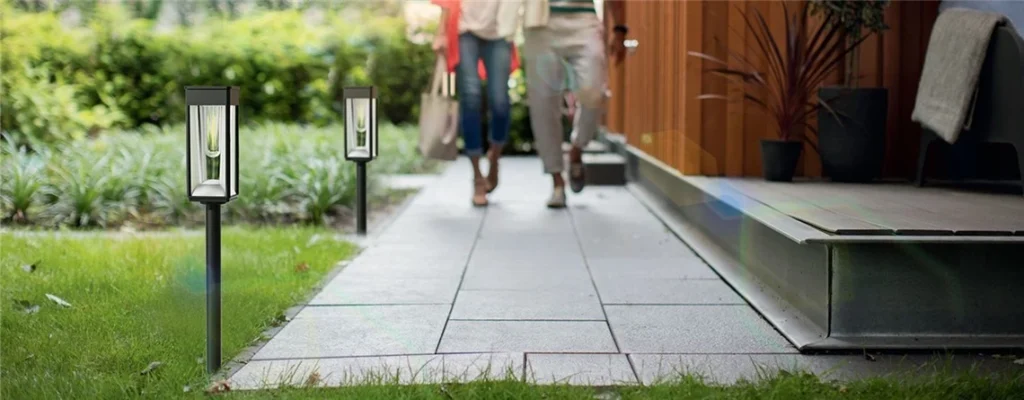
Understanding Solar Pathway Lights
Solar pathway lights are self-contained solar lighting systems designed to illuminate walkways, driveways, or garden paths. Each light typically includes a solar panel, a rechargeable battery, LED lights, and a light sensor or motion sensor for automated operation. The solar panel, made of photovoltaic cells, converts sunlight into electricity via the photovoltaic effect, charging the rechargeable battery to power the LED lights at night. These systems are ideal for off-grid lighting, requiring no wiring and offering easy installation.
The brightness of solar pathway lights, measured in lumens, ranges from 10 to 200 lumens per light, with most models producing 20-100 lumens for subtle, ambient lighting. The solar panel efficiency, typically 15-22% for monocrystalline solar panels, and battery capacity determine how long the lights stay on, usually 6-12 hours after a full charge. Understanding these specifications helps determine the optimal spacing for effective eco-friendly lighting.
Factors Influencing Spacing of Solar Pathway Lights
The ideal spacing for solar pathway lights varies based on several factors:
1. Light Brightness (Lumens)
The brightness of LED lights, measured in lumens, affects how far light spreads. Low-lumen lights (10-30 lumens) create a soft glow, requiring closer spacing (3-6 feet) for continuous illumination. Higher-lumen lights (50-100 lumens) cast a wider beam, allowing spacing of 6-10 feet. For example, solar garden lights with 50 lumens can illuminate a 4-6 foot radius, suitable for wider paths.
2. Pathway Design and Purpose
The layout and purpose of the pathway influence spacing. Straight paths benefit from uniform spacing for consistent lighting, while curved or winding paths may require closer placement (4-6 feet) to highlight turns and ensure safety. For decorative purposes, such as accentuating garden borders, solar powered lights can be spaced farther apart (8-12 feet) to create a subtle, aesthetic effect. For solar security lighting along driveways, closer spacing (5-8 feet) enhances visibility.
3. Environmental Conditions
Sunlight availability affects solar panel efficiency. In areas with ample solar exposure (5-6 hours of direct sunlight), solar pathway lights charge fully, supporting consistent performance. In cloudy or shaded areas, diffuse light reduces output, so closer spacing (3-6 feet) may compensate for dimmer illumination. Monocrystalline solar panels perform better in low-light conditions, allowing slightly wider spacing.
4. Light Beam Angle
The beam angle of LED lights determines light spread. Narrow beams (15-30 degrees) focus light directly downward, requiring closer spacing (4-6 feet) for continuous coverage. Wider beams (60-120 degrees), common in solar pathway lights, allow spacing of 6-10 feet, as they illuminate a larger area.
5. Aesthetic Preferences
Spacing also depends on visual goals. Closer spacing creates a dramatic, well-lit path, ideal for high-traffic areas. Wider spacing produces a softer, more natural look, suitable for solar garden lights in decorative settings. Balancing functionality and aesthetics is key to achieving the desired effect.
Recommended Spacing Guidelines
Based on the above factors, here are general guidelines for spacing solar pathway lights:
- Low-Lumen Lights (10-30 lumens): Space 3-6 feet apart for soft, ambient lighting on narrow paths or garden borders. Ideal for decorative solar garden lights.
- Medium-Lumen Lights (30-50 lumens): Space 5-8 feet apart for balanced illumination on standard walkways, ensuring safety and visibility.
- High-Lumen Lights (50-100 lumens): Space 6-10 feet apart for wider paths or driveways, suitable for solar security lighting or broader coverage.
- Curved or Irregular Paths: Space 4-6 feet apart to highlight turns and ensure continuous light, especially for safety-focused installations.
- Decorative Installations: Space 8-12 feet apart for a subtle, aesthetic glow, perfect for garden or landscape accent lighting.
For example, a 50-lumen solar pathway light with a 60-degree beam angle can be spaced 6-8 feet apart on a straight walkway, providing overlapping light pools for consistent illumination. Testing the layout at night helps fine-tune spacing for optimal results.
Optimizing Solar Pathway Light Performance
To ensure solar pathway lights perform effectively at the chosen spacing, consider these strategies:
- Maxhanize Solar Exposure: Position solar panels in unshaded, south-facing locations (in the Northern Hemisphere) to capture maximum solar radiation. Tilt panels to match local latitude for optimal charging.
- Choose High-Efficiency Panels: Use monocrystalline solar panels for superior solar panel efficiency (18-22%), especially in cloudy or shaded areas, to ensure consistent charging.
- Select Efficient Lights: Opt for LED lights with high lumens per watt (100-150 lm/W) to maximize brightness and reduce energy demand, allowing effective illumination at wider spacing.
- Enhance Battery Capacity: Choose solar powered lights with rechargeable batteries (e.g., 2200mAh or higher) to support 8-12 hours of operation, even in low-light conditions.
- Use Advanced Technology: Incorporate Maximum Power Point Tracking (MPPT) controllers or smart inverters to optimize energy harvest, ensuring reliable performance for solar pathway lights.
- Regular Maintenance: Clean solar panels periodically to remove dust, dirt, or snow, as these reduce solar radiation absorption. Rainfall often helps, but manual cleaning with a soft cloth and water may be needed in dry climates.
Performance in Different Conditions
Cloudy and Overcast Days
Cloudy skies reduce solar radiation, lowering solar panel output to 10-30% of optimal levels. Monocrystalline solar panels and MPPT controllers improve diffuse light capture, maintaining performance. Closer spacing (3-6 feet) may be needed in cloudy regions to ensure adequate illumination from solar powered lights.
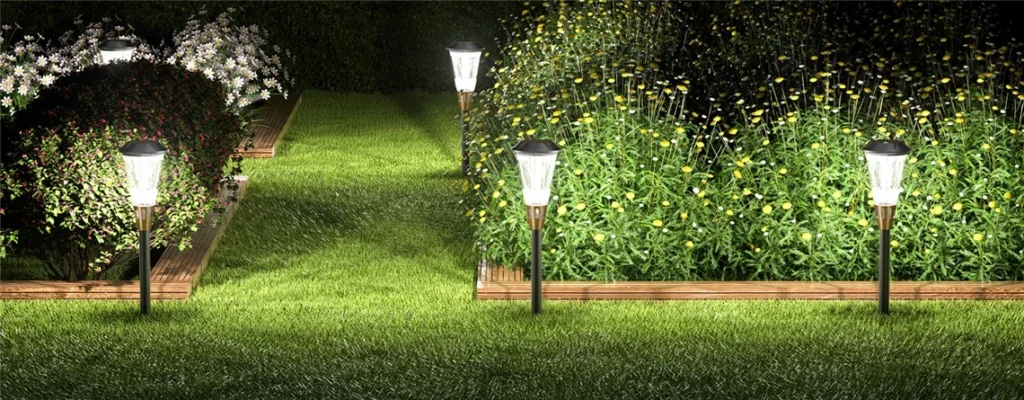
Rain and Snow
Light rain allows solar panels to charge via diffuse light, and rainfall cleans panels, enhancing solar panel efficiency. Snow can block sunlight, but angled solar panels shed snow, and cold temperatures improve photovoltaic cell performance, benefiting solar pathway lights in winter.
Shaded Areas
Shade from trees or structures reduces solar exposure, impacting light output. Bifacial solar panels, which capture reflected light, and microinverters, which optimize cell performance, mitigate shading effects. Positioning solar pathway lights in less shaded areas ensures better charging.
Benefits of Solar Pathway Lights
Solar pathway lights offer numerous advantages, making them a top choice for eco-friendly lighting. They eliminate electricity bills, reducing costs and environmental impact. Their energy-efficient lighting design, often paired with motion sensors, minimizes energy waste. Easy installation without wiring makes them ideal for off-grid lighting in gardens, walkways, or remote areas. Their durability, with IP65 or higher ratings, ensures reliability in various weather conditions, making them a practical choice for sustainable outdoor lighting.
Addressing Common Questions
A common concern is whether solar pathway lights provide enough brightness for safety. With 50-100 lumens and proper spacing (5-8 feet), they offer ample illumination for walkways. Another question is whether they function in low-sunlight areas. While direct sunlight is ideal, diffuse light and advanced solar lighting technology ensure performance, especially with closer spacing or high-efficiency components.
The Future of Solar Pathway Lighting
Advancements in solar lighting technology are enhancing solar pathway lights. Perovskite solar cells promise higher solar panel efficiency (up to 25-30%), while improved battery storage systems extend runtime. Smart technologies, such as MPPT controllers and IoT-enabled lights, allow real-time optimization, making solar powered lights more reliable and efficient. These innovations will further establish solar pathway lights as a cornerstone of renewable energy solutions.
Conclusion
The ideal spacing for solar pathway lights depends on brightness, pathway design, and environmental conditions, typically ranging from 3-10 feet. Low-lumen lights (10-30 lumens) require closer spacing (3-6 feet), while high-lumen lights (50-100 lumens) can be spaced 6-10 feet apart. By using monocrystalline solar panels, high-efficiency LED lights, and MPPT controllers, users can optimize performance and ensure consistent illumination. As eco-friendly lighting solutions, solar pathway lights offer safety, aesthetics, and sustainability, making them a smart choice for enhancing outdoor spaces with renewable energy.

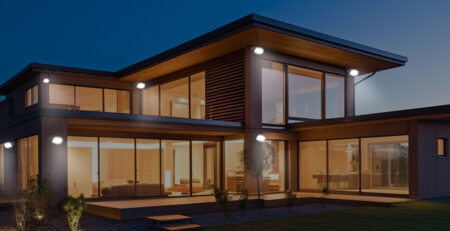


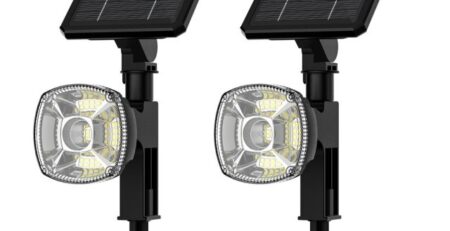

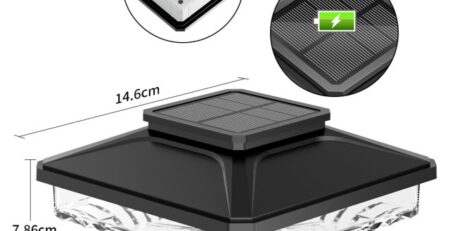
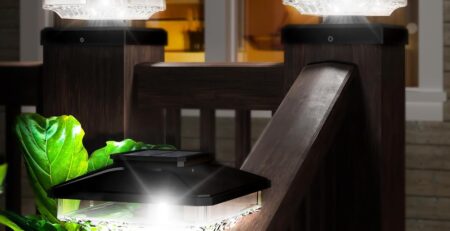
-1-450x231.webp)
-4-2-450x231.webp)

Leave a Reply